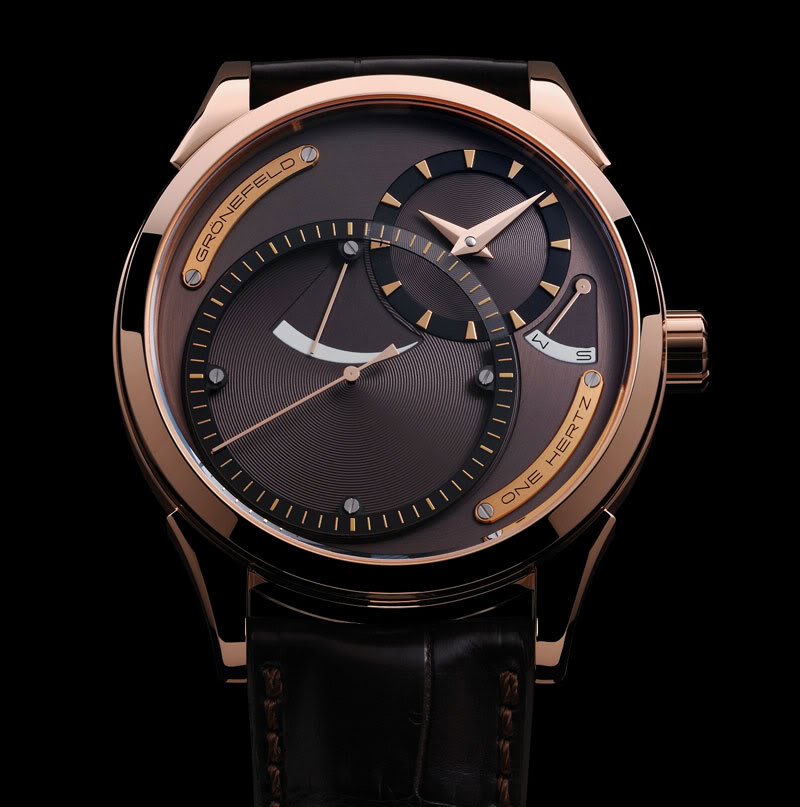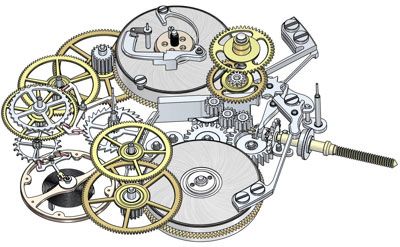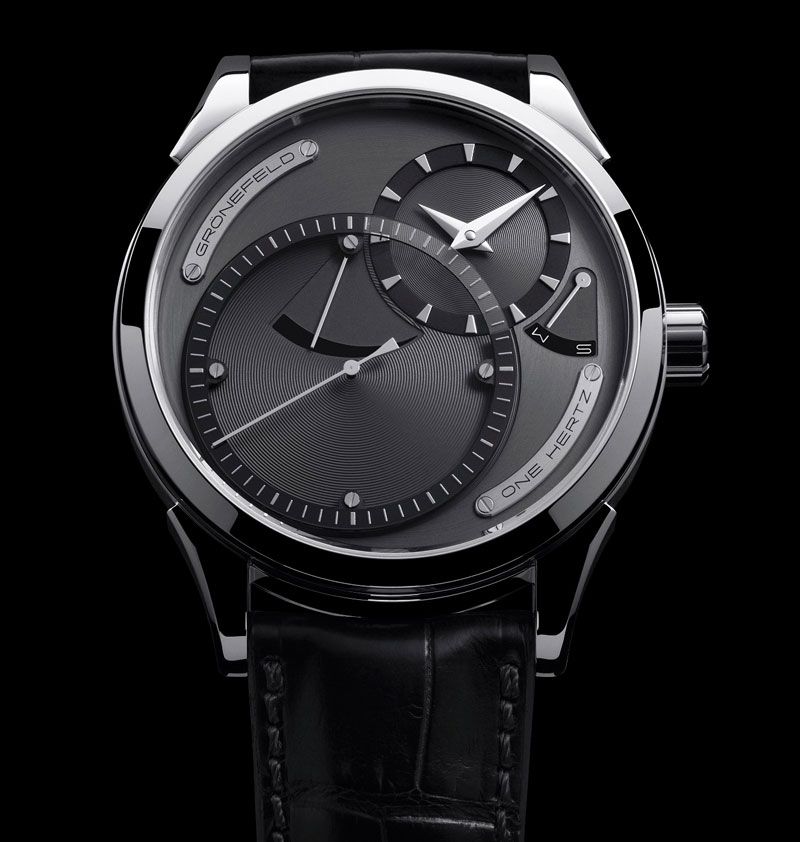Grönefeld One Hertz Dune and 1912

After the introduction of the Grönefeld One Hertz 1912, short before Baselworld 2011, Grönefeld introduces the One Hertz Dune. A beautiful version of the One Hertz in rose gold with a dark brown dial.
The Grönefeld One Hertz is the only wrist watch featuring an independent driven dead beat seconds. Because of the dedicated main spring and gear train providing the power for the dead beat seconds, or seconde morte, the watch’s rate is not influenced by this complication that usually has quite an effect on the rate.

Just imagine, an exclusive, hand-made wrist watch with a gorgeous hand-finished movement and seconds hand that ticks like a quartz watch. This may sound strange, but it’s actually very cool. Even many people who know a bit about watches, won’t have a clue about the beauty and complexity of the mechanical movement. The finishing of the movement, caliber G-02, is of the very highest level and I have written an extensive report about the finishing on The PuristS Pro AHCI forum.

Tim and Bart developed this movement specially for the One Hertz. The One Hertz indicates hours and minutes on a sub-dial at 2 o’clock and a large sub-dial for the dead seconds, giving full attention to this rare complication. At the 12 o’clock position a power reserve indicator will keep you updated on the 72 hours of power reserve. Another novelty is the innovative setting-winding indicator at 3 o’clock. By simply pushing the crown you can select between winding and setting, so no unscrewing or pulling the crown anymore.
 Displaying dead seconds in a wristwatch without a constant force device is no easy task. The friction of the mechanism has to be absolutely minimal so it does not interfere with the escapement.
Displaying dead seconds in a wristwatch without a constant force device is no easy task. The friction of the mechanism has to be absolutely minimal so it does not interfere with the escapement.
Tim and Bart Grönefeld used an independent dead seconds mechanism that is driven from its own secondary gear train with its own power supply. The seconds are driven from one mainspring barrel and the hours and minutes from another. Friction is with this system guaranteed to an absolute minimum and the complication has no adverse influence on the escapement and free sprung balance.
The two mainspring barrels are wound simultaneously from the crown, which features an innovative “push to set”, “push to wind function”, with the mode selected indicated on the dial at 3 o’clock. A power reserve indicator at the top of the dead seconds dial keeps track of the 72 hours of autonomy.
The hertz (symbol: Hz) is the SI unit of frequency defined as the number of cycles per second of a periodic phenomenon. This SI unit is named after Heinrich Hertz. One Hertz simply means “one cycle per second”.
The second (SI symbol: s), sometimes abbreviated sec., is the name of a unit of time, and is the international base unit of time. To highlight the SI seconds, the One Hertz displays dead seconds with a large seconds hand in its own dial. Hours and minutes are non-SI units of time because they do not use the decimal system so are displayed separately.
Mechanical wristwatch movements often have balance frequencies of 2.5 to 5 hertz, which results in the seconds hand making tiny steps of 5 to 10 steps each second and looking like a smooth movement. The second hand of the One Hertz is either stationary (dead) or jumping in a full one-second increment each second.

“One Hertz” Technical Specifications
- Power reserve mechanism: Classic Breguet style by means of a cone moving up and down on the threaded barrel arbour.
- Movement dimensions: 35mm x 9.4 mm
- 285 parts of which 39 jewels set in gold chatons
- Power reserve: 72 hours
- Barrels: 2 barrels, one for the going gear train and one for the independent dead seconds mechanism. Both Barrels are wound at the same speed and in the same direction
- Balance wheel: 9.12 mm free sprung variable inertia balance wheel
- Balance frequency: 21’600 bph/ 3 Hz
- Balance spring: Phillips terminal overcoil curve, triangle-style stud
- Bridges: Stainless steel hand bevelled, micro-blasted, circular grain on the top, relief engraved on micro blasted surface
- Gearing: two independent gear trains each with their own energy source
- Dead seconds mechanism: independent mechanism, cam with 30 teeth on the going gear train on the second’s wheel, escape wheel on the seconds wheel of the independent gear train, double lever with jewelled pallets.
The case measures 43 mm and is 12.5mm thick. Sapphire crystal on both sides, on the dial side the crstal is domed and antireflective coated on both sides, the flat sapphire crystal on the back is antireflective coated on the inside.
The Grönefeld One Hertz is available in two limited versions. The One Hertz 1912 in stainless steel is limited to 12 pieces and priced at € 29,500 Euro before tax. The One Hertz Dune is limited to 20 pieces and is priced at € 49,500 Euro before tax.



